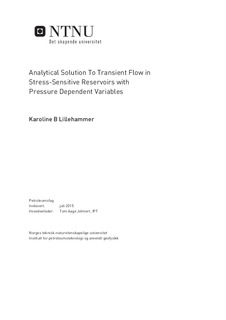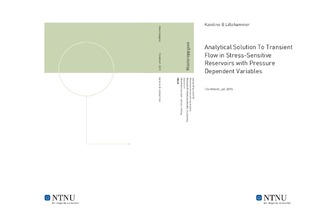| dc.description.abstract | New technology and knowledge gives increasing confidence in investments of unconventional reservoirs. In these types of reservoirs the rock and fluid parameters are often seen to depend strongly on pressure. Conventional well testing equations do not account for stress-sensitivity and assume all reservoir and fluid parameters to be constant. This thesis will suggest a new solution for transient flow by extending the diffusivity equation where pressure dependency of permeability, viscosity, compressibility and thickness is included.
The diffusivity equation becomes strongly non-linear when including pressure dependent parameters. All the pressure dependent variables are assumed to vary exponentially with pressure. Using these exponential relations the model incorporates the pressure dependent variables into a single pressure dependent variable T_n. The normalized transmissibility variable, T_n is a pressure dependent variable and a function of the combined dimensionless elasticity modulus, tau_D, used to describe the degree of stress-sensitivity. Introducing T_n enables the equation to be solved analytically, creating a model that intends to provides better prediction of pressure and flow behavior for stress-sensitive reservoirs.
Special attention is given to the pressure dependency of the reservoir thickness near the well and it is found that stress-sensitivity can cause deformation here. This deformation is found both for the case of drawdown and buildup pressures. It is observed that the deformation during drawdown is larger than the reversed deformation during buildup. By increasing the degree of stress-sensitivity both these phenomenons are also found to increase. From the buildup solution it can thereby be concluded that not all deformation can be reversed by increasing pressure. Hence it indicates the importance of being able to predict deformation early in the life of a field, so that pressure support can be applied before deformation becomes irreversible.
The derived analytical equations are incorporated into well tests to compare against homogeneous solutions. A deviation from homogeneous values is found for all well test cases. The model can also account for storage and skin by the use of Laplace space solutions. The stress sensitivity has little effect on the early time unit slope for storage. Adding skin causes an extra pressure increase at intermediate and late times. | |

